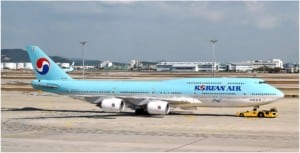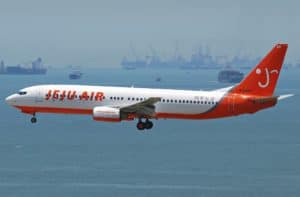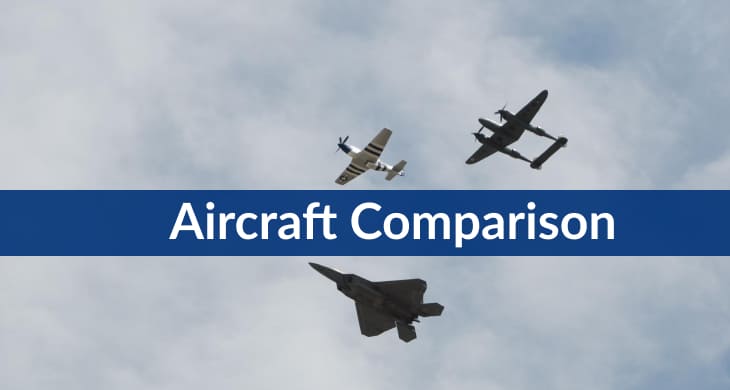It’s a battle as old as time or at least as old as commercial aviation. The mighty 747 vs 737. Which is better? This blog post will look at the two aircraft and see which one comes out on top.
| Aircraft: | Boeing 747-8 | Boeing 737-800 |
|---|---|---|
| Photo: |
 |
 |
| Country: | United States | United States |
| Manufactured: | from: 2008 to: Present | from: 1998 to: Present |
| ICAO: | B748 | B738 |
| Price: | $418.4 million | $89.2 million |
| Avionics: | Rockwell Collins Avionics | Rockwell Collins avionics |
| Engine: | 4x General Electric GEnx 2B67 | 2x Snecma / CFM56-7B27 |
| Engine Type: | Turbofan | Turbofan |
| Power: | 66,500 pound-force | 27,300 pound-force |
| Max Cruise Speed: |
533 knots 987 Km/h |
473 knots 876 Km/h |
| Approach Speed (Vref): | 145 knots | - |
| Travel Range: |
8,000 Nautical Miles
14,816 Kilometers |
3,060 Nautical Miles
5,667 Kilometers |
| Fuel Economy: |
0.12 nautical mile / gallon 0.059 kilometres / litre |
0.44 nautical mile / gallon 0.215 kilometres / litre |
| Service Ceiling: | 43,000 feet | 41,000 feet |
| Rate of Climb: |
2500 feet / minute 12.70metre / second |
- |
| Take Off Distance: |
3190 metre 10,465.75 feet |
2316 metre 7,598.33 feet |
| Landing Distance: |
2680 metre 8,792.54 feet |
1372 metre 4,501.26 feet |
| Max Take Off Weight: |
447,696 Kg 986,991 lbs |
384,039 Kg 846,652 lbs |
| Max Landing Weight: |
312,072 Kg 687,994 lbs |
- |
| Max Payload: |
76,067 Kg 167,697 lbs |
21,319 Kg 47,000 lbs |
| Fuel Tank Capacity: |
63,034 gallon 238,609 litre |
6,875 gallon 26,025 litre |
| Baggage Volume: |
161.5 m3 5,703 ft3 |
45.1 m3 1,593 ft3 |
| Seats - Economy: | 467 seats | 189 seats |
| Seats - Business Class: | 600 seats | 175 seats |
| Seats - First Class: | 467 seats | 162 seats |
| Cabin Height: |
2.39 metre 7.84 feet |
2.2 metre 7.22 feet |
| Cabin Width: |
6.1 metre 20.01 feet |
3.54 metre 11.61 feet |
| Cabin Length: |
63.25 metre 207.51 feet |
29.97 metre 98.33 feet |
| Exterior Length: |
76.25 metre 250.16 feet |
39.5 metre 129.59 feet |
| Tail Height: | 19.51 metre - 64.01 feet | - |
| Fuselage Diameter: |
6.49 metre 21.29 feet |
3.76 metre 12.34 feet |
| Wing Span / Rotor Diameter: |
68.4 metre 224.41 feet |
34.31 metre 112.56 feet |
| Wing Tips: | Raked Wingtips | No Winglets |
| More Info: | Boeing 747-8 | Boeing 737-800 |
|
Data presented is for entertainment purposes and should not be used operationally.
|
Other Boeing 747-8 comparisons:
Other Boeing 737-800 comparisons:
About the Boeing 747
The Boeing 747 is a large, long-range airliner with a widebody fuselage. It was first flown commercially on 9 Feb 1969 and is still in production today. And it can carry up to 660 passengers and has a range of nearly 7,500 miles.
Why was it developed and built?
The Boeing 747 is a widebody jet airliner with four engines, typically used for long-haul flights. It was first developed in the 1960s by American manufacturer Boeing in response to the growing demand for air travel.
What purpose does it serve?
The Boeing 747 is a large commercial airliner that can carry up to 660 passengers. It is mainly used for long-distance flights and operates between cities separated by thousands of miles.
Its four powerful engines give it the range to cover these distances in a single flight, making it highly cost-effective for airlines. In addition, its large fuselage gives it the capacity to carry more passengers than any commercial airliner.
About the Boeing 737
The Boeing 737 is a narrowbody airliner first flown commercially in 1968. It is still in production today and is one of Boeing’s best-selling aircraft. And it can carry up to 210 passengers and has a range of just over 3,800 miles.
Why was it developed and built?
The Boeing 737 is a single-aisle jet airliner with two engines, typically used for short-haul flights. Think of it as a smaller version of the 747. Designed to meet the growing demand for air travel, it quickly became one of the most popular airliners in the world.
What purpose does it serve?
Remember, the Boeing 737 is designed for short-haul flights. As such, it would be used to connect relatively close cities. Its two powerful engines give it the range to reach these destinations in a single flight, making it an efficient and cost-effective option for airlines.
How are the Boeing 747 and Boeing 737 different?
Let’s take a closer look at these two widely popular planes.
Size
The Boeing 747 is a jumbo jet, while the Boeing 737 is a narrowbody plane. This means that the Boeing 747 is significantly larger than the Boeing 737; it can carry up to 66% more passengers.
The Boeing 747 also has a wider fuselage, allowing more cargo space. As a result, it is better suited for long-haul flights, while the Boeing 737 is better suited for short to medium-haul flights.
Speed
The Boeing 747 has a cruising speed of 933 km/h, while the Boeing 737 has a cruising speed of 838 km/h. While this may not seem like a significant difference, it is; when you’re talking about an aircraft that weighs hundreds of thousands of pounds, even a small increase in speed can make a big difference.
Fuel Efficiency
Another critical difference between these two aircraft is fuel efficiency. The Boeing 747 burns approximately 10 gallons of fuel per mile, while the Boeing 737 burns approximately 5 gallons per mile. This makes the Boeing 737 much more fuel efficient than the Boeing 747, which is essential given the high cost of jet fuel.
Range
One significant difference between them is the range. The Boeing 747 range is around 10,800 – 14,320 km, while the Boeing 737 range is 2850 – 7130 km. This is because the Boeing 747 was designed for long-haul flights, while the Boeing 737 was designed for shorter flights between cities.
Passenger Capacity
As mentioned, the Boeing 747 can seat upwards of 660 passengers, while the Boeing 737 can seat approximately 150. This difference in capacity is because the Boeing 747 is a widebody plane while the Boeing 737 is a narrowbody plane.
The wider body of the Boeing 747 allows it to accommodate more passengers than the narrower body of the Boeing 737.
How are the Boeing 747 and Boeing 737 similar?
The Boeing 747 and the Boeing 737 are two of the most popular jetliners in the world.
Both planes are highly automated, with fly-by-wire systems that help to reduce pilot workload. They also use two engines designed with the same wing shape, giving them similar performance capabilities.
Overall, the Boeing 747 and the Boeing 737 are two of the most famous aircraft in the world, with similar performance capabilities and passenger capacities.
What’s better about the Boeing 747?
Here are some things that make the 747 an excellent choice for air travel:
- It can carry a lot of passengers. The Boeing 747 seats 660 passengers, making it ideal for large groups or families.
- It has a large cargo capacity and can carry up to 100 tons of cargo, making it perfect for shipping freight or large items.
- It is fuel efficient and uses less fuel than other aircraft types, making it more environmentally friendly.
- It has a long range and can fly up to 8,000 miles without stopping, making it perfect for long-distance travel.
- It is comfortable and has wider seats and more legroom than other aircraft types, making it more comfortable for passengers.
What’s better about the Boeing 737?
The Boeing 737 is better in several ways.
- First, the Boeing 737 has a longer range. This means that you can fly further without having to stop to refuel.
- Second, the Boeing 737 is more fuel efficient. This means you’ll save money on fuel costs over the life of the aircraft.
- Third, the Boeing 737 is more comfortable for passengers. The seats are wider, and there is more legroom in the cabin.
- Finally, the Boeing 737 is quieter. This means that passengers will have a more enjoyable flight experience.
Conclusion
In the battle of big jets, it’s hard to beat the mighty Boeing 747. But if you’re looking for something more fuel-efficient with lower operating costs, then the Boeing 737 is your best bet.


